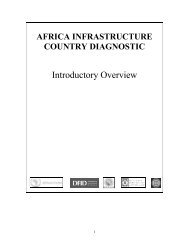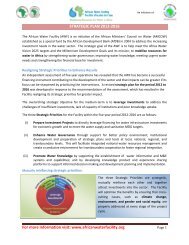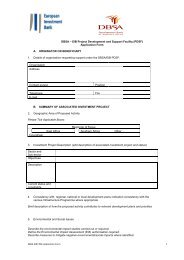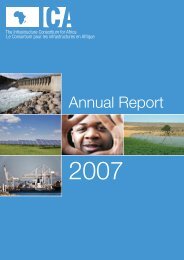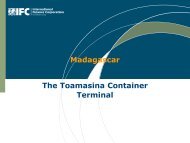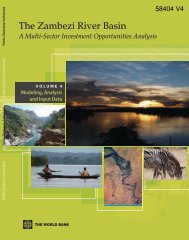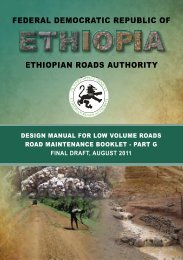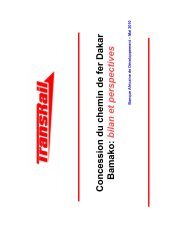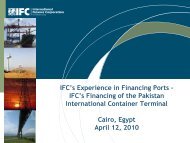Design-Manual-for-Low-Volume-Roads-Part-A
Design-Manual-for-Low-Volume-Roads-Part-A
Design-Manual-for-Low-Volume-Roads-Part-A
Create successful ePaper yourself
Turn your PDF publications into a flip-book with our unique Google optimized e-Paper software.
A - Chapter 1 - 6<br />
This problem is worsened in areas where there is a prevalence of expansive, black cotton soils. These soils<br />
have high agricultural potential, but become weak and slippery when wet. They often cannot support<br />
even the lightest vehicles. Where gravel is placed directly over this material it may rut under the influence<br />
of traffic and mix into the weak soil below.<br />
Vehicle operating costs (VOCs) are high on roads with high roughness and restricted access. VOCs<br />
include repairs, maintenance, fuel and tyre replacement. The consequence is that transport operators<br />
tend to avoid roads with high roughness and other defects <strong>for</strong>cing people to walk long distances to reach<br />
the nearest point where transport services are prepared to operate.<br />
Dust is often overlooked as a problem on unpaved roads. It is caused by the action of traffic and wind.<br />
Unpaved roads lose fine material which can travel over 100 metres from the road. The dust affects other<br />
road users, pedestrians and school children, houses, shops and crops near the road. <strong>Roads</strong> in dry areas<br />
can lose up to 33 tonnes of surface fines per kilometre per year. Dust has significant and costly social<br />
(cleanliness), health (eye and respiratory hazards), environmental (crop and natural habitat damage) and<br />
economic (vehicle and equipment damage, pedestrian and vehicle safety) consequences. Approaches to<br />
alleviate dust problems, particularly in populated areas are offered in the <strong>Manual</strong>.<br />
Gravel <strong>for</strong> road works is a non-renewable natural resource. On unpaved roads it is used as a sacrificial<br />
layer and must be periodically replaced. Optimal materials <strong>for</strong> gravel surfaced roads are not commonly<br />
found in Ethiopia, and it is possible to lose up to 150mm of gravel per year depending on conditions.<br />
Gravel roads require a continuous cycle of reshaping and regravelling to maintain the required running<br />
surface and the desired level of service. The type of materials prevalent in Ethiopia, the nature of the<br />
climate and the terrain presents significant challenges to achieving this type of maintenance. Screening<br />
and blending techniques are available to improve the properties and such techniques are described in<br />
the <strong>Manual</strong>.<br />
The major technical challenges <strong>for</strong> unpaved roads are to provide durable and functional water crossings,<br />
surfacing with materials that provide the desired and necessary level of service and to provide effective<br />
maintenance management. These challenges are recognised in the <strong>Manual</strong> and in many cases options<br />
and solutions are offered to mitigate and manage problems.<br />
1.4 <strong>Low</strong> volume paved roads<br />
The design manual draws on international research carried out over several decades. This research was<br />
carried out by a number of research organisations in collaboration with national road authorities, including<br />
the Ethiopian <strong>Roads</strong> Authority. Much of the research was aimed at deriving local specifications, designs<br />
and techniques <strong>for</strong> improving the cost-effective provision of low volume roads sealed with a bituminous<br />
or alternative, non-bituminous surfacing and advanced thinking on provision of more appropriate<br />
geometric, drainage and pavement design standards. Innovative construction techniques and methods<br />
were identified that optimised the use of local labour, introduced intermediate equipment techniques and<br />
improved opportunities <strong>for</strong> the local private sector to participate in road construction and maintenance.<br />
The research questioned existing paradigms associated with paved surfacing design <strong>for</strong> low volume<br />
roads. This research, combined with local experience, provided a basis <strong>for</strong> understanding how such roads<br />
deteriorate leading to the development of revised standards, specifications and design methods that<br />
make better use of locally available materials and demonstrate an effective range of viable bituminous<br />
and non-bituminous surfacing technologies.<br />
The approaches adopted <strong>for</strong> the design of low volume paved roads differs in a number of fundamental<br />
respects from roads carrying higher traffic volumes. In particular, the relative influences of road<br />
deterioration factors are significantly different <strong>for</strong> low volume roads compared with higher volume roads.<br />
A critical observation is that <strong>for</strong> sealed roads, carrying below about 1.0 Mesa pavement deterioration<br />
was controlled mainly by how the road responded to environmental factors, such as moisture changes<br />
in the pavement layers, fill and subgrade and to the effects of age hardening of bituminous surfacings.<br />
The appropriate design options <strong>for</strong> low volume roads there<strong>for</strong>e need to be responsive to a wider range<br />
of factors captured in the road environment, the most critical being the internal and external drainage.<br />
PART A: DESIGN STANDARD APPROACHES




